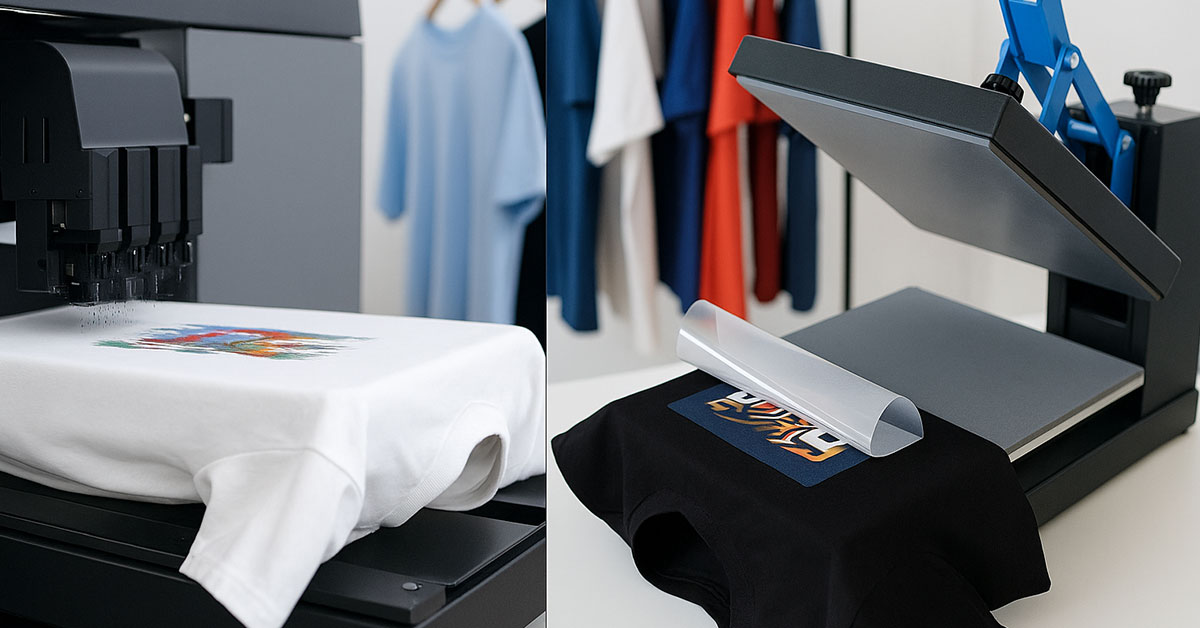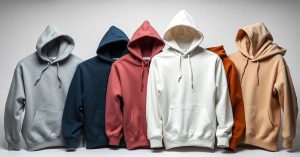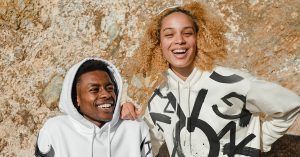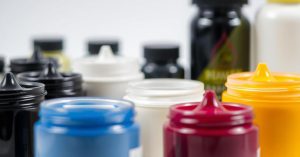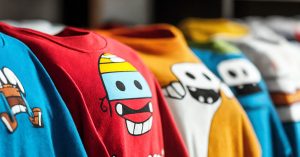Planning your custom garment printing project and wondering which is better DTG or DTF for your specific needs? Understanding the fundamental differences between these two popular printing methods is crucial for making informed decisions that ensure you get the best value, quality, and results for your custom apparel project. Both direct-to-garment and direct-to-film printing offer unique advantages, but selecting the right approach depends on your budget, design requirements, fabric preferences, and quantity needs.
Key Takeaways
- Understand the fundamental differences between DTG and DTF printing methods.
- Explore fabric compatibility to ensure the right choice for your projects.
- Assess print quality and durability factors to enhance your offerings.
- Consider initial investment and operational costs for long-term success.
- Evaluate production speed and efficiency for greater productivity.
Table of Contents
Understanding Direct-to-Garment (DTG) Printing
Direct-to-garment printing represents the premium approach to custom apparel decoration, delivering exceptional detail and natural feel that makes your designs look like they were woven into the fabric itself. This advanced printing technique has become the go-to choice for customers seeking high-quality, professional results that maintain the original comfort and drape of their garments.
What to Expect from DTG
The DTG printing process creates stunning results by applying specially formulated water-based ink directly onto the fabric using advanced inkjet technology, similar to how your home printer works but designed specifically for textiles. Your garments undergo careful preparation to ensure optimal color vibrancy and longevity, resulting in prints that feel soft and natural against your skin.
When you choose DTG printing, expect vibrant colors, sharp details, and prints that maintain the original texture of your garment. The process works particularly well for intricate designs, photographic images, and artwork with subtle color gradations that other printing methods might struggle to reproduce accurately.
Professional DTG machines ensure consistent quality across your entire order, with sophisticated color management systems that deliver accurate color reproduction every time. This precision makes DTG ideal for projects where color matching is critical or when you’re reproducing existing brand colors.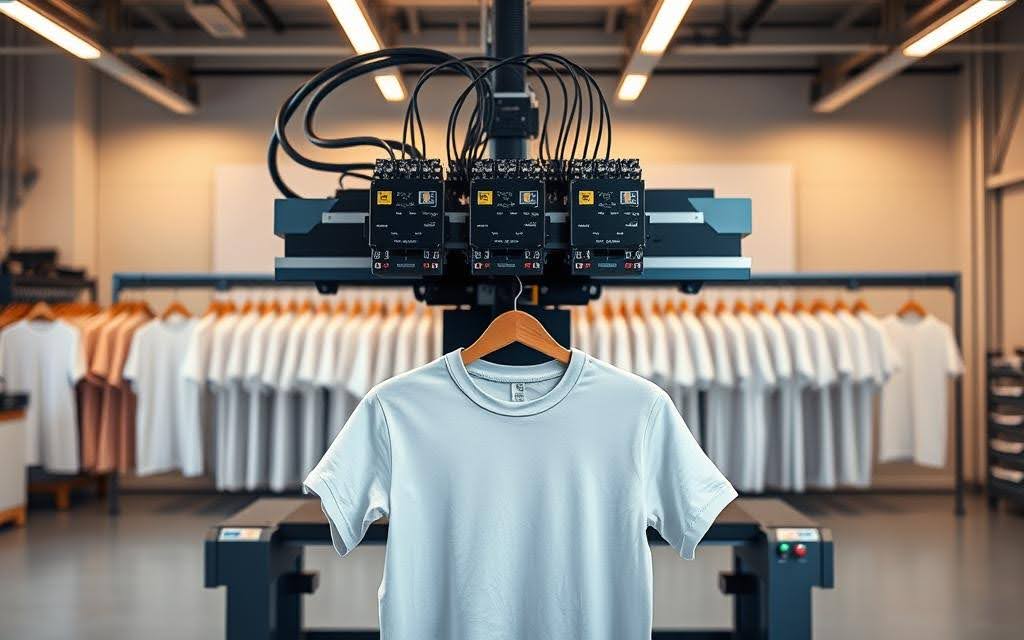
Best Fabrics for DTG
DTG printing delivers exceptional results on cotton and cotton-blend garments, where the natural fibers readily accept the water-based ink and create lasting, vibrant prints. If you’re looking for the softest possible feel and most natural appearance, choose 100% cotton garments for your DTG project.
Cotton blends can also produce excellent results, though higher cotton content generally yields better color vibrancy and durability. While synthetic materials like polyester can be printed with specialized DTG processes, you’ll typically get better value and results by choosing natural fiber garments for your DTG project.
Fabric Type | DTG Results | Recommended For | What to Expect |
100% Cotton | Excellent | Premium projects, detailed designs | Soft feel, vibrant colors, excellent durability |
Cotton Blend (70%+) | Very Good | Everyday wear, cost-effective | Good color, comfortable feel, solid durability |
Cotton Blend (50-70%) | Good | Budget-friendly options | Acceptable quality, moderate durability |
Polyester | Fair | Specialized applications only | Limited color options, may require premium pricing |
Tri-blend | Very Good | Premium comfort garments | Ultra-soft feel, good color reproduction |
Exploring Direct-to-Film (DTF) Printing
Direct-to-film printing offers incredible versatility and value, making it possible to achieve professional results on virtually any fabric type while maintaining competitive pricing for your custom apparel projects. This innovative approach creates durable prints that maintain excellent quality across diverse materials, giving you more options for your creative vision.
What DTF Offers You
The DTF printing process creates your designs on specialized transfer film before applying them to your garments using professional heat press equipment, ensuring consistent quality and strong adhesion across different fabric types. This method allows for vibrant colors and sharp details while offering more flexibility in material selection than traditional printing methods.
When you choose DTF printing, you’ll receive prints with excellent color saturation and durability that can withstand regular washing and wear. The process works exceptionally well for bold graphics, text-heavy designs, and situations where you need consistent results across multiple fabric types or colors.
DTF transfers can be stored and applied on-demand, making this method particularly efficient for projects with tight deadlines or when you need flexibility in production timing. This storage capability also enables better inventory management if you’re planning multiple product launches or seasonal collections.
Fabric Flexibility with DTF
DTF printing excels at delivering consistent, high-quality results across an extensive range of materials, from traditional cotton and blends to challenging synthetic fabrics like polyester, nylon, and performance materials. This versatility means you’re not limited in your fabric choices and can select materials based on your specific needs rather than printing compatibility.
Whether you’re working with light or dark fabrics, DTF printing maintains consistent color vibrancy without requiring different processes or premium pricing for darker materials. This consistency makes project planning easier and more predictable, especially when working with multiple garment colors or types.
DTF printing also works well on specialty materials like canvas, denim, and even some leather goods, opening up possibilities for unique promotional items or fashion applications that wouldn’t be possible with other digital printing methods.
Which is Better DTG or DTF?
Determining which is better DTG or DTF for your project depends on your specific priorities regarding quality, feel, durability, budget, and timeline requirements. Each printing method excels in different areas, making them more suitable for specific applications and customer needs rather than one being universally superior to the other.
Quality and Appearance Comparison
DTG printing delivers the finest detail reproduction and most accurate color matching, particularly on light-colored cotton garments where the water-based ink can fully integrate with the fabric fibers. The result feels remarkably natural and soft, often making it difficult to distinguish the printed area from the original fabric texture.
DTF printing produces vibrant, eye-catching prints with excellent color saturation that pops off the garment, thanks to its white ink backing system that ensures consistent color reproduction across different fabric colors. While the print may feel slightly different from the base fabric due to the transfer film layer, modern DTF produces very comfortable, flexible results.
For photographic reproductions or designs requiring subtle color transitions, DTG printing typically provides superior results. For bold graphics, logos, or designs where vibrant colors are the priority, DTF printing often delivers more impactful visual results.
Durability and Longevity
DTF prints generally offer superior wash fastness and longevity across various fabric types, maintaining their appearance and structural integrity through numerous wash cycles when properly cared for. The adhesive bonding system creates strong mechanical adhesion that resists cracking, peeling, and fading under normal use conditions.
DTG printing achieves excellent durability on compatible fabrics, particularly cotton and cotton blends, where the water-based ink chemically bonds with the fiber structure. However, longevity can vary based on fabric type and care practices, requiring you to follow care instructions more carefully for optimal results.
Both methods will serve you well with proper care, but DTF printing tends to be more forgiving of different washing conditions and fabric types, making it ideal if your garments will see heavy use or varied care practices.
Feel and Comfort
DTG printing creates the most natural feel of any digital printing method, with prints that blend seamlessly into the fabric and maintain your garment’s original comfort and drape. This makes DTG ideal for fashion applications, premium garments, or any situation where comfort is your primary concern.
DTF printing produces a slightly different hand feel due to the transfer film layer, though modern materials have significantly reduced this difference compared to older technologies. The result remains comfortable and flexible for most applications, particularly when you prioritize durability and versatility over absolute softness.
Your choice often depends on your priorities and intended use, with fashion-focused projects typically benefiting from DTG’s natural feel while promotional, workwear, or high-durability applications often preferring DTF’s resilience and versatility.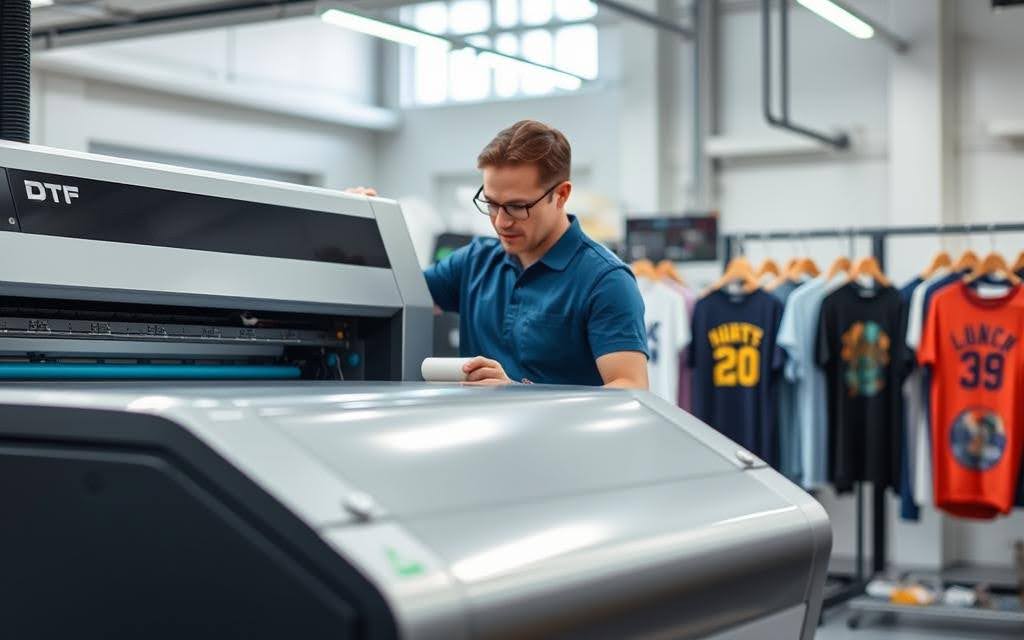
Cost Considerations for DTG and DTF Printing
Understanding how printing costs affect your final product pricing is crucial when choosing between DTG and DTF printing methods for your custom apparel projects. The printing method your supplier uses directly impacts the prices you’ll pay, delivery times, and minimum order requirements, making it essential to understand these differences when planning your budget and expectations.
Pricing Structure Impact
DTG printing typically results in higher per-piece costs due to the expensive equipment and complex processes involved, but these costs are often justified by superior print quality and natural feel on cotton garments. You’ll generally find that DTG printing services charge premium prices for their offerings, particularly for single-piece orders or small quantities.
DTF printing usually offers more competitive pricing, especially for bulk orders, because the printing process is more cost-effective for service providers to operate. The lower overhead costs of DTF printing equipment often translate to better value for customers, making it an attractive option for budget-conscious projects without compromising on durability.
Cost Factor | DTG Printing Impact | DTF Printing Impact |
Single Item Cost | Higher ($12-25 per piece) | Lower ($8-18 per piece) |
Bulk Order Pricing | Moderate discounts available | Significant bulk discounts |
Setup Fees | Often waived for digital orders | Minimal to no setup fees |
Rush Order Charges | Higher due to complex process | Lower due to efficient workflow |
Dark Garment Surcharge | Common (white ink costs) | Rarely applied |
What Affects Your Final Price
DTG printing costs vary significantly based on your design complexity, garment color, and fabric type, with dark-colored shirts often carrying surcharges due to additional white ink requirements. Your design’s color count and coverage area directly impact pricing, as more colors and larger designs require more ink and processing time.
DTF printing offers more predictable pricing structures since costs are primarily determined by design size rather than color complexity or garment color. This transparency makes budgeting easier for your projects, especially when working with intricate designs or multiple color combinations that might be expensive with other printing methods.
Production Timeline and Delivery Expectations
Understanding production timelines helps you plan your project effectively and set realistic expectations for when you’ll receive your custom apparel. The printing method you choose significantly impacts how quickly your order can be completed and delivered, affecting everything from event planning to inventory management.
DTG printing involves multiple processing steps including pre-treatment, printing, and curing phases that require specific timing and environmental conditions. While individual garments can be produced relatively quickly, the overall production cycle may take longer due to these sequential processing requirements and quality control measures.
DTF printing offers more flexible production scheduling since designs can be pre-produced during slower periods and applied to garments when needed. This separation of design creation from garment application often results in faster turnaround times, especially for rush orders or projects with tight deadlines.
Both methods can accommodate print on demand requirements, but DTF printing typically offers more flexibility for last-minute changes or quick additions to existing orders. DTG printing excels for single-piece or small-batch custom orders where each item may have unique personalization requirements.
Consider your project timeline carefully when choosing between methods, as DTF printing generally provides faster delivery options while DTG printing may require additional production time but delivers superior quality for specific applications. Discuss your timeline requirements with your printing service provider to ensure they can meet your delivery needs with your chosen method.

